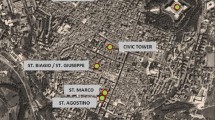Abstract
This paper presents the comparative results of the static and dynamic monitoring of damaged masonry macro-elements. The structural health monitoring (SHM) has been carried out over 3 years. The crack opening displacement of the main shear cracks of the overturning mechanisms of the façade, of the bottom walls of transept and the cracks of the arches was monitored using extensometers. Moreover, dynamic sensors for measuring accelerations were used and through the registration of each major seismic vibration event, a modal identification of output-only systems was carried out; the main frequencies were identified. This work highlights the structural damage detection methodology and shows the differences between global and local damage detection techniques. The static monitoring presents the displacement trend of each monitored main crack with its respective temperature–time history. The results of both long-term monitoring systems are compared to develop the reliability and the correlation of the static and dynamic parameters over 3 years. Static and dynamic monitoring are useful to check both the level of damage and the degradation of the cracking survey, to evaluate the interaction with the safety measures, and also to analyze the stability of signals by varying the intrinsic and environmental conditions such as temperature. This research reveals a good reliability between the static and dynamic results, particularly on the detection of the effect of a safety intervention. Moreover, the results highlight the limits and merits of each monitoring system.

















Similar content being viewed by others
References
Bednarza ŁJ, Jasieńko J, Rutkowski M, Nowaka TP (2014) Strengthening and long-term monitoring of the structure of an historical church presbytery. Eng Struct 81:62–75. https://doi.org/10.1016/j.engstruct.2014.09.028
Masciotta MG, Ramos LF, Lourenço PB (2017) The importance of structural monitoring as a diagnosis and control tool in the restoration process of heritage structures: a case study in Portugal. J Cultural Heritage 27:36-47. doi.org/10.1016/j.culher.2017.04.003
Boscato G, Dal Cin A (2017) Experimental and numerical evaluation of structural dynamic behavior of Rialto bridge in Venice. J Civil Struct Health Monit 7(4):557–572. https://doi.org/10.1007/s13349-017-0242-7
Ceravolo R, De Marinis A, Pecorelli ML, Zanotti Fragonara L (2017) Monitoring of masonry historical constructions: 10 years of static monitoring of the world's largest oval dome. Struct Control Health Monit. https://doi.org/10.1002/stc.1988
Dal Cin A, Russo S (2016) Annex and rigid-box diaphgram effect in failure analysis of historic churches hit by earthquake. Eng Failure Anal 59:122–139
Boscato G, Dal Cin A, Lentile S, Russo S (2016) Optimized procedures and strategies for the dynamic monitoring of historical structures. J Civil Struct Health Monit 6(2):265–289. https://doi.org/10.1007/s13349-016-0164-9
Podestà S, Riotto G, Marazzi F (2008) Reliability of dynamic identification techniques connected to structural monitoring of monumental buildings. Struct Control Health Monit 15(4):622–641. https://doi.org/10.1002/stc.219
Pau A, Vestroni F (2013) Vibration assessment and structural monitoring of the Basilica of Maxentius in Rome. Mech Syst Signal Process 41(1–2):454–466
Mesquita E, Arêde A, Silva R et al (2017) Structural health monitoring of the retrofitting process, characterization and reliability analysis of a masonry heritage construction. J Civil Struct Health Monit 7:405. https://doi.org/10.1007/s13349-017-0232-9
Saisi A, Gentile C, Ruccolo A (2016) Pre-diagnostic prompt investigation and static monitoring of a historic bell-tower. Constr Build Mater 122:833–844
Potenza F, Federici F, Lepidi M et al (2015) Long-term structural monitoring of the damaged Basilica S Maria di Collemaggio through a low-cost wireless sensor network. J Civil Struct Health Monit 5:655. https://doi.org/10.1007/s13349-015-0146-3
Wu H, Zonta D, Pozzi M, Zanon P, Corrà M (2010) Historic buildings: long term stability evaluation using wireless sensor networks. Adv Mater Res 133–134(2010):235–240. https://doi.org/10.4028/www.scientific.net/AMR.133-134.235
Inaudi D, Glišiæ B (2008) Overview of fibre optic sensing applications to structural health monitoring. In: Proceedings of the symposium on geodesy for geotechnical and structural engineering, Lisbon
Lopez-Higuera JM, Rodriguez Cobo L, Quintela Incera A, Cobo A (2015) Fiber optic sensors in structural health monitoring. J Lightwave Technol. https://doi.org/10.1109/JLT.2011.2106479
Joel Poling N, Desai G, Fischer G, Fischer CG (2018) Effect of out-of-plane specimen movement on strain measurement using digital-image-correlation-based video measurement in 2D and 3D. J Civil Struct Health Monit 8(5):1–22. https://doi.org/10.1007/s13349-018-0277-4
Winkler J, Duus Hansen M (2018) Innovative long-term monitoring of the great belt bridge expansion joint using digital image correlation. Struct Eng Int 28(1):1–6. https://doi.org/10.1080/10168664.2018.1461539
Mesas-Carrascosa FJ, Santano DV, Meroño de Larriva JE, Cordero RO, Fernández REH, García-Ferrer A (2016) Monitoring heritage buildings with open source hardware sensors: a case study of the Mosque-Cathedral of Córdoba. Sensors (Basel) 16(10):1620. https://doi.org/10.3390/s16101620
Mesquitaa E, Arêdea A, Pinto N, Antunesb P, Varum H (2018) Long-term monitoring of a damaged historic structure using a wireless sensor network. Eng Struct 161:108–117. https://doi.org/10.1016/j.engstruct.2018.02.013
S. Russo (2013) On the monitoring of historic Anime Sante church damaged by earthquake in L’Aquila. Struct Control Health Monit 20(9):1226–1239. https://doi.org/10.1002/stc.1531
Di Giulio G, Vassallo M, Boscato G, Dal Cin A, Russo S (2014) (2014) Seismic monitoring by piezoelectric accelerometers of a damaged historical monument in downtown L’Aquila. Ann Geophys 57(6):S0654. https://doi.org/10.4401/ag-6671
Boscato G, Ceravolo R, Fragonara LZ, Russo S (2015) Global sensitivity-based model updating for heritage structure. Comput Aided Civil Infrastruct Eng 30(8):620–635
DIANA (2010) DIANA user’s manual release 9.4.2. TNO, Delft
Van der Auweraer H, Guillaume P, Verboven P, Vanlanduit S (2001) Application of a fast-stabilizing frequency domain parameter estimation method. ASME J Dyn Syst Meas Control 123(4):651–658
LMS Test.Lab: Siemens PLM software. https://www.lmsintl.com
Acknowledgements
The authors thank the technical staff of LabSCo (Laboratory of Strength of Materials) of IUAV University of Venice for their support during the installation and monitoring phases. Financial support by the research project AQ DPC/ReLUIS 2014–2018_UR IUAV-DPPAC_RS 4_ “Seismic observatory of structures and monitoring” is gratefully acknowledged by the authors.
Author information
Authors and Affiliations
Corresponding author
Ethics declarations
Conflict of interest
The authors declare that they have no conflict of interest.
Additional information
Publisher's note
Springer Nature remains neutral with regard to jurisdictional claims in published maps and institutional affiliations.
Rights and permissions
About this article
Cite this article
Dal Cin, A., Russo, S. Evaluation of static and dynamic long-term structural monitoring for monumental masonry structure. J Civil Struct Health Monit 9, 169–182 (2019). https://doi.org/10.1007/s13349-019-00324-z
Received:
Accepted:
Published:
Issue Date:
DOI: https://doi.org/10.1007/s13349-019-00324-z




